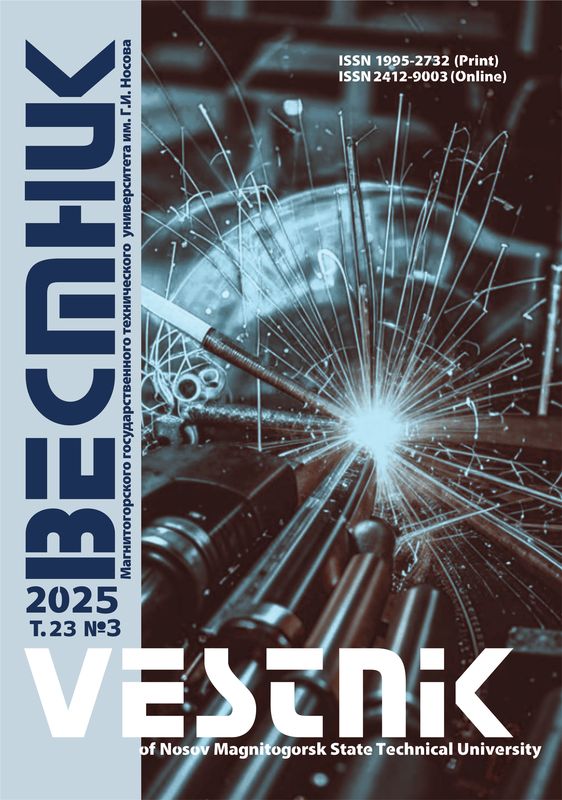DOI: 10.18503/1995-2732-2024-22-1-49-60
Abstract
The development of new technologies for the production of long-length deformed semi-finished products from precious metal alloys and, in particular, palladium-based alloys, is a currently relevant task of metallurgical production. This is especially important for manufacturing technical products designed for high-precision electrical appliances and devices that are currently manufactured abroad. The presented research solves the task of developing a technology for producing wire from a new palladium-based alloy with a given set of physical and mechanical, and operational properties. First of all, this is achieved, as based on a patent analysis of available technical solutions, the authors proposed and patented a palladium alloy designed for thermal deformation treatment and producing wire contacts for transmitting video signals. To develop reduction modes and determine force parameters, the DEFORM-3D software package was applied for simulation by an approximation formula for calculating ultimate tensile strength depending on the total degree of reduction, which was necessary to create computer models of the long product rolling and drawing processes. The models were used to study the features of metal shaping, and the stress and strain state, determine the power parameters of these processes and evaluate them from the standpoint of limiting the permissible load of equipment, as well as the possibility of workpiece fracture during rolling, using the Cockcroft-Latham criterion. To validate the computer models for adequacy, the authors carried out experimental studies on the long product rolling and drawing processes, whose results provided for a possibility of producing experimental samples of wire and study the physical and mechanical properties and the metal structure. The conducted experimental studies of the process of producing technical wire from a new palladium alloy have shown that the proposed reduction modes can be used to produce wire with a diameter of up to 0.5 mm and the required level of mechanical and electrical characteristics. The results of the conducted research can serve as a basis for developing an industrial technology using equipment available at plants for treatment of precious metals and their alloys.
Keywords
palladium, alloys, wire, long product rolling, drawing, power parameters, annealing, physical and mechanical properties
For citation
Sidelnikov S.B., Lopatina E.S., Lopatin V.A., Belyaev S.V., Arnautov A.D., Ditkovskaya Yu.D. Research on the Production Technology for Technical Wire from a New Palladium Alloy. Vestnik Magnitogorskogo Gosudarstvennogo Tekhnicheskogo Universiteta im. G.I. Nosova [Vestnik of Nosov Magnitogorsk State Technical University]. 2024, vol. 22, no. 1, pp. 49-60. https://doi.org/10.18503/1995-2732-2024-22-1-49-60
1. Sidelnikov S.B., Lopatina E.S., Dovzhenko N.N. et al. Tekhnologicheskie osnovy proizvodstva dlinnomernykh litykh i deformirovannykh polufabrikatov iz splavov dragotsennykh metallov: monografiya [Technology of production of long cast and deformed semi-finished products from precious metal alloys: monograph]. Krasnoyarsk: Siberian Federal University, 2022, 204 p. (In Russ.)
2. Brepol E. Teoriya i praktika yuvelirnogo dela [Theory and practice of jewelry]. Saint Petersburg: Solo, 2000, 528 p. (In Russ.)
3. Savitsky E.M. Blagorodnye metally: sprav. izd. [Noble metals: reference book]. Moscow: Metallurgiya, 1984, 592 p. (In Russ.)
4. GOST 30 649-99. Splavy na osnove blagorodnykh metallov yuvelirnye. Marki [Noble metal-based alloys for jewelry. Grades]. Moscow: Standartinform, 2000. (In Russ.)
5. Milkina A. Will the prices for platinum and palladium rise in 2023 and is it worth investing in them? Available at: https://www.banki.ru/news/daytheme/?id=10978312
6. Rudnitsky E.A., Dovzhenko N.N., Khodyukov B.P. Study on the properties of new palladium alloys and improvement of their treatment technology. Vestnik Magnitogorskogo gosudarstvennogo tekhnicheskogo universiteta im. G.I. Nosova [Vestnik of Nosov Magnitogorsk State Technical University]. 2009;(3):41-44. (In Russ.)
7. Biront V.S., Dovzhenko N.N., Mamonov S.N. et al. Materialovedenie. Metallovedenie palladiya i ego splavov: ucheb. posobie [Materials science. Metal science of palladium and its alloys: study guide]. Krasnoyarsk: State University of Non-Ferrous Metals and Gold, 2007, 152 p. (In Russ.)
8. Rudnitsky E.A. Sovershenstvovanie tekhnologii proizvodstva provoloki iz palladievykh yuvelirnykh splavov: dis. … kand. tekhn. nauk [Improving the technology of wire production from palladium jewelry alloys: PhD (Eng.) thesis]. Krasnoyarsk, 2009, 221 p.
9. Alan Sydney Darling. An improved electrical resistance alloy. Patent GB, no. 861646A, 1959.
10. Arthur S. Klein, Edward F. Smith, III. Silver palladium alloy. Patent US, no. 5484569A, 1996.
11. Sidelnikov S.B., Lopatina E.S., Lopatin V.A. et al. Splav na osnove palladiya [Palladium-based alloy]. Patent RU, no. 2788879, 2023.












